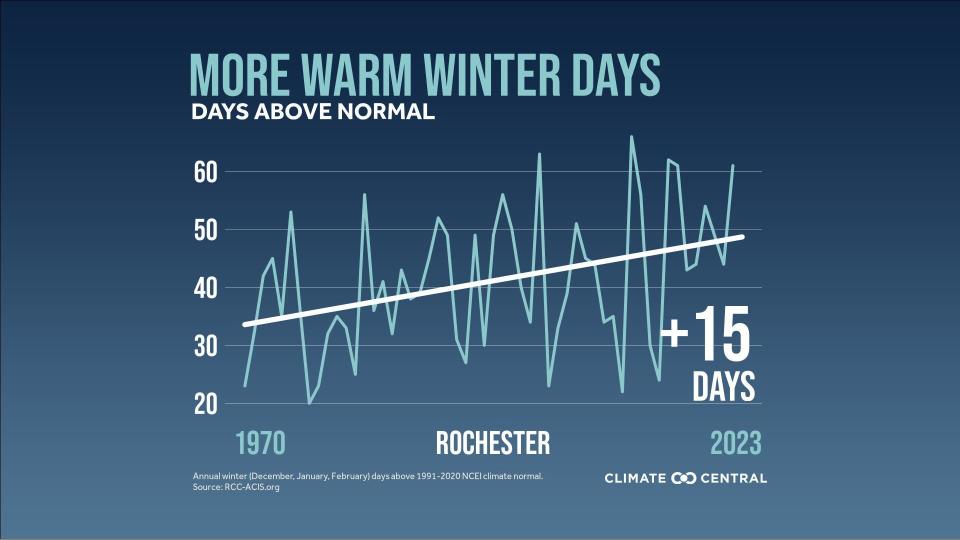Daily high temperatures, such as Rochester’s balmy Christmas Day, often grab the attention, including headlines from us.
Yet warm overnight temperatures are better indicators of our warming climate, with nights heating faster than days in much of the United States, according to the 2023 National Climate Assessment. The number of nights with a minimum temperature of 70 degrees or above is increasing everywhere in the U.S. except for the Northern Great Plains and Alaska.
The nighttime temperature in Rochester on Dec. 28 caught the attention of Climate Central, a nonprofit group of scientists and communicators.
It was 20 degrees higher than normal. That’s an unusual swing.
Climate Central’s Climate Shift Index marked last Thursday evening as unusually warm — and attributed the temperature extreme to the climate crisis. The low temperature for the day was 42 degrees, only 7 degrees less than the high temperature, and about 20 degrees warmer than the average low, according to the National Weather Service in Buffalo.
So what is the Climate Shift Index? It’s a categorical scale, ranging from -5 to 5, which quantifies the influence of climate change on the temperature on a given day.
The night temperature in Rochester on Dec. 28 rated at a 4 on the scale, which is considered “extreme” on the Climate Shift Index.*
It is snowing less in Rochester now
Warmer winter days have increased in frequency since 1970, with an average of an additional 15 days of above average temperatures now, according to Climate Central. The impact is illustrated in our precipitation totals in December.
While the Weather Service’s climate summary on Dec. 29 showed precipitation totals for the month are slightly above the normal value (2.8 inches to 2.5 inches), the amount of snowfall is tracking well behind norms.

There have been 5 inches of total snow in December, which is 15.7 inches fewer than normal.
It should be familiar, though. Rochester had only 4.8 inches of snowfall in December last year, while also featuring below-normal precipitation. Last winter, only 50.7 inches of snow fell, well below the average of about 100 inches snow.
More: It’s an El Niño winter. What that means for Rochester.
More: When is the winter solstice? Rochester’s longest night is coming
The Details: Climate model tracks warming world
* Climate Central’s Climate Shift Index describes the rating as conditions being at least four times as common to occur as a result of climate change; the same conditions would be extremely rare without it.
-
In the explainer of in its website, Climate Central explains the index doesn’t mean climate change caused hot weather on any given day, but does attempt to use the analytical models that undergird it to illustrate how climate change increased the possibility of those temperatures.
-
The negative numbers on the Climate Shift Index scale indicate how much less likely a temperature event is due to climate change.
— Steve Howe covers weather, climate and lake issues for the Democrat and Chronicle and is ready for some snow. Have any insight into changing winter weather? Share with him at showe@gannett.com.
This article originally appeared on Rochester Democrat and Chronicle: Rochester NY weather climate high temperatures
Signup bonus from




